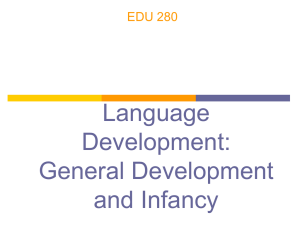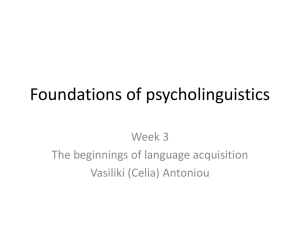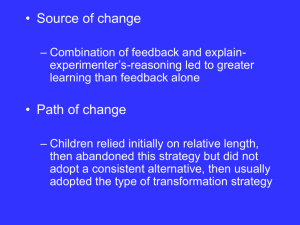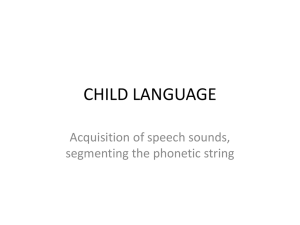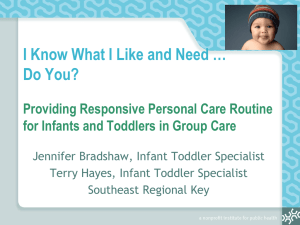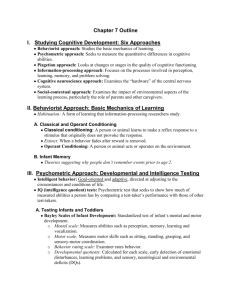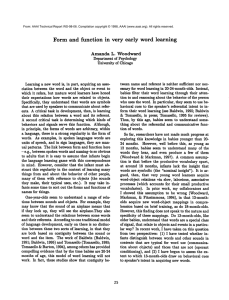How Babies Talk
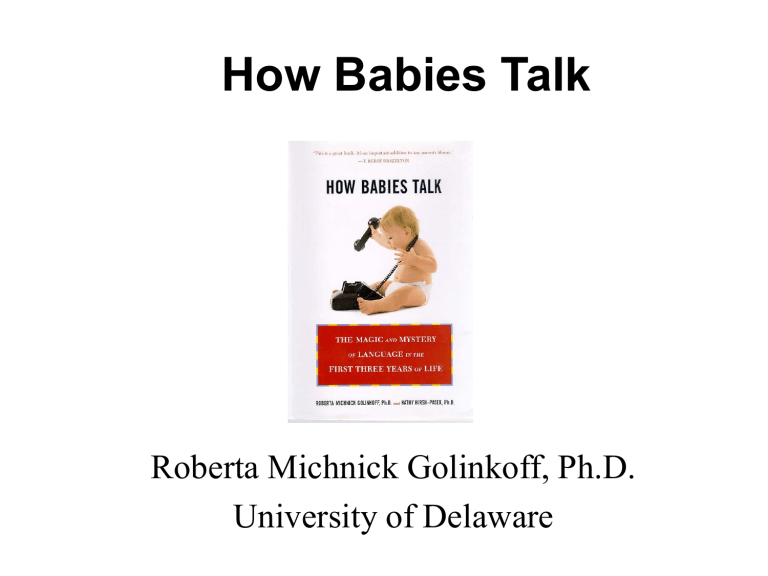
How Babies Talk
Roberta Michnick Golinkoff, Ph.D.
University of Delaware
Four takeaway points…
• Children learn language early!
• Infants bring a great deal with them for language learning. They are brilliant at it!
• Responsive, sensitive input is critical.
• We all make a difference.
Today’s talk
• Language - An introduction to the problem space
• What we see when our children learn to talk
• What we don’t see
– A revolution in our understanding of the problem space
• Implications & Applications
Language can start wars ruin marriages allow a workshop
Humans are the only species to have language
• Allows us to share thoughts and feelings
• Transmit knowledge and culture
• Say what we want in our coffee
• Represent our world and talk about it
We all take language quite for granted…..
Yet, how we learn language has been a great mystery throughout time
Part 1:The “problem space”
Mapping sounds to meanings
And meanings to sounds
Consider the task that faces the language-learning child
They hear a sound
Or maybe many sounds
While they see something interesting…
The infants’ job????
But this task is deceivingly difficult because….
• There are so many ways to divide the sounds we hear
– Is it, “Lobster” or “clobster,” “Do you like lobster?”
• So may ways to divide the events we see
– When we say “bear” to a child, is it the whole bear or the fur? Or the paws?
• So many ways to map the words and sentences onto those parts of the events
While this poses a logical problem, children figure all of this out even before they …
• Can tie their shoes
• Can be trusted alone
• Can be taken to fancy restaurants
In fact, it is so easy for babies that typically developing children can learn multiple languages better than we can!
How??????
Part II: What you see… original theories were based on production , or what the child could do that you could see
What you see: Landmarks in production
• 0-3mo: coos
• 3-6 mo: coos; laughs
• 6-9 mo: babbling “ma ma da da”
• 9-12mo: points; first words; mixing it up - “bada”
• 12-18mo: 2 words per week; 50 words at
– 18 mo., names for body parts, animals, imitates,
– Social joint attention used for language
• 18-24 mo: naming explosion; “Whas sat?”;
– Talk about here and now; loves stories over and over; follows simple commands
What you see… continued
• 2-3 yrs: 500 wds; asks questions;
– past tense; Wh-; sits 20 minutes; WHY?; pronounce clearly - m, n, f, b, d, h, y; uses fuller sentences with
“in,” and “on.”; girls might appear to stutter
• 3-4 yrs: 800 wds; contractions - won’t;
– can’t; can follow plot in story line; time words morning, afternoon; adds sounds k, g, r, l; may still distort some as in “birfday” - th; wonderful new made-up words like, “Michael wave” or “vampire”
What you see… continued
• 4-5 yrs: 2000 words; speaks clearly can make up stories; use complex sentences; still some mispronounciations.
• 5-7 yrs: retells stories with more depth;
– participates in discussions; learns relationships like big/little/happy/sad
• 1st grade: 11,000 words
• 3rd grade: 20,000 words
• 5th grade: 40, 000 words
• YOU: 52,000 words
QuickTime™ and a
Video decompressor are needed to see this picture.
A cautionary note
• Pediatricians have had this chart for a long time
• Different strokes for different folks
– Groups
– Individuals
– Cultures
There is a lot of variation! These were just general guides to the patterns in language development
Part III: What you don’t see…
Current theories are based on what you can’t see with the naked eye….
The last 50 years: A revolution in our understanding of how children solve this age-old problem
The 21st Century Baby
There’s a lot more going on than meets the eye!
Carving the sounds of language…
We have discovered that…..
Babies are amazing!
Even in the womb, eavesdropping on every conversation Mom has!
Did you know …….
• At birth, babies recognize their mother’s voice over a strange female’s?
• Recognize their own language over a foreign language?
• Can remember stories and songs they heard while in utero?
• Can discriminate between phonemes, e.g., /b/ vs. /d/, found in all the world’s languages?
Carving up the world of objects and events….
Infants can…
• Attend to and categorize properties of objects in the first year of life, e.g., cups vs. plates.
• Infants have some sense of causality, gravity, and spatial aspects of objects all in the first year
• Recent research also suggests that they are noting properties of events like motion, path of motion and manner of motion
And what do we know about the…??????
world sound
A LOT!!!!!
Mapping sounds to meaning when learning words…
• Infants of 10 mo will map a word onto the most interesting object they see, regardless of what speaker is naming!
• By 19 mo., they notice speaker intent and will label even a boring object if a speaker is looking at it or touching it (taking the speaker’s point of view)
• By 24 mo., they are word learning experts!!!
Can’t be fooled by an attractive object; just use speaker’s intent
Mapping sequences of words when learning grammar?
Babies can map sequences of words to specific meanings by 17 months when they are only saying as few as 2 words!
Hirsh-Pasek, K. & Golinkoff, R.M., (1996) The Origins of grammar: Evidence from comprehension ,
Cambridge, Mass:MIT Press
.
But you are rightfully incredulous: How do we know all of this about baby competencies?
• A host of new methodologies offers researchers a window onto the baby’s mind!
Qui ckTime™ and a
TIFF (U ncompr essed) decompressor are needed to see thi s pi cture.
And what a mind it is!
You can just see this mind working behind these eyes!
The High Amplitude Sucking Paradigm
Perception of sounds
The Interactive Intermodal Preferential Looking
Paradigm
Mapping of words
“Where’s the ball?”
“Do you see the ball? Look at the ball!”
The Intermodal Preferential Looking
Paradigm
Mapping of grammar
•
These new methods fuel the revolution, revealing
Amazing infant competencies in segmenting the sound and the world (perception)
• Infants’ abilities to map sounds to the meanings they stand for -- especially for early object names
• Infants’ ability to use social cues in determining sound to word and sound to sentence meaning
Part IV: Applications
Ingredients for best outcomes…
• Need interactive, responsive environments
• Need to hear enough language data to do statistics on
• Need not only a LOT of language input, but varied input
Data from parenting with typical children
Hart and Risley Study
Differences in Language Experience
50
45
40
Millions of
Words
Addressed to
Child
35
30
25
20
15
10
5
0
Prof.
Wking Cls
Welfare
12 24 36
Age in Months
48
In the US, poverty is associated with less input
What doesn’t matter...
Neither
• race
• gender
• ethnic origin
• birth order -- first, second, or only child
What does matter?
Amount of input
We also know how to apply what we have learned about the importance of input
• Provide stimulating and responsive language input
• Read -- read--read, and then read some more
• Tell stories - don’t need a Ph.D.!
• Language play - bababa
Yet, we must also be mindful of what to do when something goes wrong
• If no words at 18 mo.
• Doesn’t respond to his own name
• Little eye contact
• Not putting words together by 2 and a half.
• Do not seem to understand simple commands at 18 months.
CALL a THERAPIST!!!
Concluding points for applications
• Children learn language early!
• Responsive, sensitive input is critical
• Input comes many forms:
- in what they hear and see (the perceptual);
- who they interact with (the social);
- the full sentences we use to convey what we mean
(grammatical building blocks)
Most frequently asked questions?????????????
• Do girls learn faster than boys?
• Do first-born’s speak earlier?
• Does learning sign language help a child learn faster and raise his or her
IQ?
• Do children who are bilingual speak later?
• Do twins speak later?
• Do children with ear infections have problems learning language?
• Does watching TV hinder language development?
QuickTime™ and a
Photo - JPEG decompressor are needed to see this picture.
Remember that they’re at language learning.


